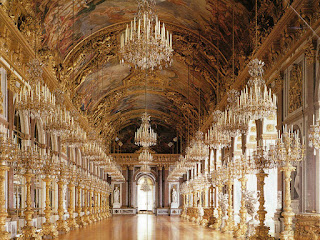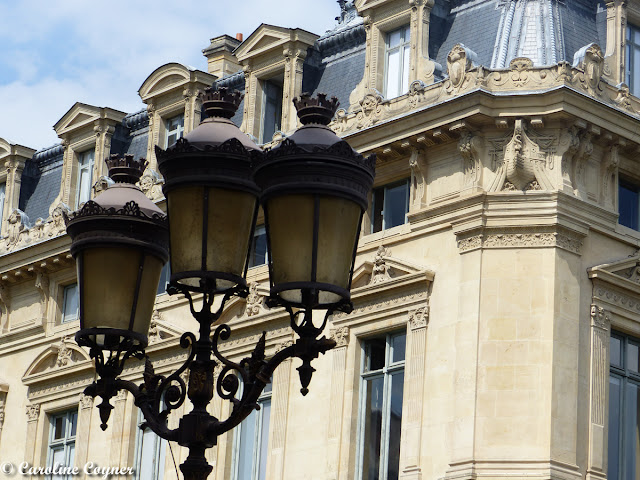Today glisten is definitely a word most of us would associate with chandeliers. When we think of chandeliers, we usually think of a giant, ornate, crystal covered fixture that features dozens of lights and seems like it could illuminate an entire stadium… albeit a small one! Of course such chandeliers do exist, but that’s definitely not how they got started.
 |
| An electric version of an early wooden cross chandelier |
As manufacturing techniques and materials evolved, chandeliers became far more varied and elegant. While wooden chandeliers remained a staple for centuries, over time metals, glasses and crystals would come to dominate the chandelier universe. This is particularly true of wealthy households and in public spaces that were intended to impress nobles and commoners alike.
By the late 17th century chandeliers were quite ornate, with long curved arms, dozens of candles and unique designs. Although the majority of pieces at the time were still wood and cast metals, gilding was an increasingly sought after feature. In the 18th century developments in Bohemien glassmaking allowed lead crystal, with its light refracting facets, to become a common element of high end chandeliers. At the same time, the Venetians, not wanting to be left out of the mix, began crafting unique chandeliers of their own which included intricate carvings of leaves, flowers, fruits as well as a spectrum of colors that were a specialty of Murano. In addition, Murano glass, because of its unique properties, was some of the lightest glass in the world, which allowed for more decoration without adding tremendously to the weight of the piece. These embellishments were particularly important to Venetian success as Murano glass was not suitable for faceting.
For a short period in the 19th and early 20th century gas replaced candles as the primary light source for chandeliers. Soon thereafter however, as access to electricity became widespread and dependable, it replaced gas as the main light source for chandeliers. In the case of some extraordinary chandeliers, they started out with candles, were reworked to use gas then they were reworked again for electricity.
 |
| The Hall of Mirrors at Herrenchiemsee |
Today chandeliers come in all shapes and sizes. Some are shimmering with countless faceted crystals while others are made of wrought iron. Still others are made of brass or even wood. A chandelier is often the first item that attracts the eye and as such usually sets the tenor of the room. Whether it’s in a brightly lit dining room with a high white ceiling or a dusky wood paneled den, like the cherry on top of a sundae, finding just the right chandelier can pull all of a room’s elements together and create an ambience that is far more than the sum of its parts.
A French Six-Light Iron Chandelier with Applied Gilded Elements. Circa 1960.

An Art Deco Chandelier with mirrored ball
An Italian Basket Crystal Four-Light Chandelier with Crystal Center Column and Gold Mercury Glass Accents. Early 20th Century.
A Dale Chihuly glass chandelier
A French Eight-Light Wrought Iron Round Chandelier with Twisted Arms. Circa 1940 or 1950.
A Lüsterweibchen Austrian Light Fixture - c. 1820-30 consisting of the torso of a maiden with "Antlers Wings" and a Coat of Arms.
A Pair of Italian Early 19th Century Crystal Chandeliers With Wooden Central Column, Multiple Faceted Crystals and Swoop Gilded Arms. 2 Available, Priced and Sold Separately.
A French Vintage Eight-Light Painted Iron Chandelier with S-Scroll Arms
from the Mid 20th Century.
from the Mid 20th Century.

Empire 24 Carat Gold Hotel Chandelier
Beautiful Italian Late 18th Century ~ Early 19th Century Church Hanging Lantern. Wonderful Paint and Carving.
An Exquisite 10-Light Italian 19th Century and Later Crystal Chandelier with Blue Crystals and Central Painted Wooden Column.
A French Six-Light Painted Wood Chandelier with Barley Twist Central Column and Arms from the 20th Century.
Chandeliers hanging in the Jai Vilas Palace in Gwalior, India
A Lovely Italian 18 Lights on Two Level Crystal Chandelier from the Mid 20th Century. At the Lower Level, the Lights' Arms Alternate in Width, Giving a Lot of Life to this Chandelier.
A French Vintage Painted Iron Six-Light Chandelier with Flower Shaped Bobeches
from the Mid 20th Century.
from the Mid 20th Century.
The chandelier in the Small Senate Rotunda of the U.S. Capitol
A Very Large Size Forged Iron Eight Light Chandelier made of Old French Arms and Two Tiered Newer Rings, with Diamond Patterns. Mid 20th Century. Adjustable height.
A Crystal Italian 12-Light Chandelier with 2-Tiered Bobeches and Gilded Iron Armature.
Mid 20th Century.
A Porcelain Chandelier in Schloss Herrenchiemsee
A 19th Century Italian Eight-Light Silver Gilt Chandelier with Leaf Arms and Flower Shaped Bobeches.
An Italian Six-Light Crystal Chandelier with Lower Round Crystal Finial, From the 1950's - 1960's.
A Pair of 19th Century Italian Three-Arm Painted and Gilded Wood Chandeliers with Swoop Arms, Tassels and Floral Decor.
And if you'd like to see how modern crystal chandeliers are made, watch the great video above.















































































